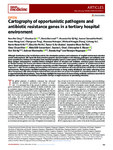2020-06-08Zeitschriftenartikel
Cartography of opportunistic pathogens and antibiotic resistance genes in a tertiary hospital environment
Chng, Kern Rei
Li, Chenhao
Bertrand, Denis
Ng, Amanda Hui Qi
Kwah, Junmei Samantha
Low, Hwee Meng
Tong, Chengxuan
Natrajan, Maanasa
Zhang, Michael Hongjie
Xu, Licheng
Ko, Karrie Kwan Ki
Ho, Eliza Xin Pei
Av-Shalom, Tamar V.
Teo, Jeanette Woon Pei
Khor, Chiea Chuen
MetaSUB Consortium
Chen, Swaine L.
Mason, Christopher E.
Ng, Oon Tek
Marimuthu, Kalisvar
Ang, Brenda
Nagarajan, Niranjan
Although disinfection is key to infection control, the colonization patterns and resistomes of hospital-environment microbes remain underexplored. We report the first extensive genomic characterization of microbiomes, pathogens and antibiotic resistance cassettes in a tertiary-care hospital, from repeated sampling (up to 1.5 years apart) of 179 sites associated with 45 beds. Deep shotgun metagenomics unveiled distinct ecological niches of microbes and antibiotic resistance genes characterized by biofilm-forming and human-microbiome-influenced environments with corresponding patterns of spatiotemporal divergence. Quasi-metagenomics with nanopore sequencing provided thousands of high-contiguity genomes, phage and plasmid sequences (>60% novel), enabling characterization of resistome and mobilome diversity and dynamic architectures in hospital environments. Phylogenetics identified multidrug-resistant strains as being widely distributed and stably colonizing across sites. Comparisons with clinical isolates indicated that such microbes can persist in hospitals for extended periods (>8 years), to opportunistically infect patients. These findings highlight the importance of characterizing antibiotic resistance reservoirs in hospitals and establish the feasibility of systematic surveys to target resources for preventing infections.
Dateien zu dieser Publikation

